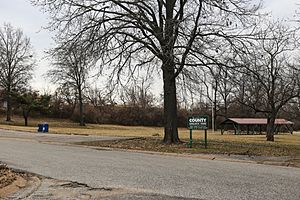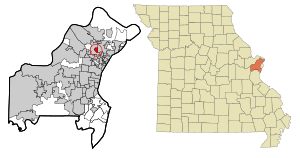Kinloch, Missouri facts for kids
Quick facts for kids
Kinloch, Missouri
|
|
|---|---|
|
City
|
|
| City of Kinloch | |

Kinloch Park
|
|
 |
|
| Country | United States |
| State | Missouri |
| County | St. Louis |
| Founded | November 17, 1890 |
| Government | |
| • Type | Mayor–council government |
| Area | |
| • Total | 0.73 sq mi (1.88 km2) |
| • Land | 0.73 sq mi (1.88 km2) |
| • Water | 0.00 sq mi (0.00 km2) |
| Elevation | 574 ft (175 m) |
| Population
(2020)
|
|
| • Total | 263 |
| • Density | 361.76/sq mi (139.72/km2) |
| Time zone | UTC-6 (Central (CST)) |
| • Summer (DST) | UTC-5 (CDT) |
| FIPS code | 29-38972 |
| GNIS feature ID | 2395541 |
| Website | City of Kinloch |
Kinloch is a small city in St. Louis County, Missouri. In 2020, about 263 people lived there.
Kinloch is special because it was the first African-American community in Missouri to become an official city. For many years in the 1800s and 1900s, it was a busy and successful black community. However, in the 1980s, its population started to shrink. This happened because the city of St. Louis bought many homes. This was part of a plan to reduce noise from the nearby St. Louis Lambert International Airport.
Between 1990 and 2000, Kinloch lost over 80% of its people. The city faced many challenges. But in recent years, people have been working hard to rebuild Kinloch.
Contents
History of Kinloch
The city of Kinloch grew around an area called Kinloch Park. This area was first developed as a suburb for people who commuted to work in the 1890s.
Early African-American Community
A family named "B" is believed to be the first black family to buy a home in Kinloch Park. When their white neighbors found out, they quickly sold their own homes. Soon, white people stopped buying properties in South Kinloch Park.
Within a few years, more than 30 black families bought homes there. This six-block area became known as South Kinloch Park.
How Kinloch Grew
Kinloch became an African-American community in a unique way. It was similar to how Brooklyn, Illinois developed. At the time, it was not legal to sell land directly to black people. So, a company called Olive Street Terrace Realty Corporation sold land to white people first. They paid about $150 for each piece of land.
Then, these white owners sold the land to black people for about $350. This method allowed the company to use the white people's loans to get more money from banks. The company even advertised in the Argus newspaper. They said, "The good colored people of South Kinloch Park have built themselves a little city of which they have a right to be proud." They mentioned that over a hundred homes, three churches, and a great public school were built in just a few years.
Kinloch Airfield and Aviation Firsts
Kinloch Park once had a horse-racing track called Kinloch Track. When horse racing became illegal in Missouri, the land was used for Kinloch Airfield. This airfield saw many important moments in aviation history.
In October 1910, the Aero Club of St. Louis held the first international air meet there. Theodore Roosevelt became the first U.S. president to fly in an airplane. Pilot Arch Hoxsey flew President Roosevelt for over three minutes in a Wright Brothers plane.
Kinloch Airfield was also home to several other "firsts":
- The first control tower for airplanes.
- The first meal served on a flight.
- The first airmail ever shipped.
- The first parachute jump.
- The first aerial photo taken from a plane.
- The first time an animal was airlifted.
Albert Bond Lambert was the first person in the St. Louis area to get a pilot's license. He and other members of the Aero Club leased the field in 1920. In 1923, they renamed it the Lambert-St. Louis Flying Field. Lambert bought the field in 1925. Then, in 1928, he sold it to the city of St. Louis for the same price he paid. This made it the first city-run airport. Today, it is known as Lambert-St. Louis International Airport.
Community and Education
Kinloch was home to a local chapter of the Universal Negro Improvement Association (UNIA). This group helped black-owned businesses in the area. Elijah Woodson was the chairman of this chapter.
In 1902, white residents of Kinloch Park decided to leave the Ferguson school district. They built a new school for white students called Nuroad school. Their old two-room school was given to black students. These black students had been using the 1885 Vernon schoolhouse.
In 1913, the Dunbar Elementary school was built for black children in South Kinloch. It was named after the poet Paul Laurence Dunbar. This school remained segregated (meaning only black students could attend) until it closed in 1975. It holds the record as the longest-running school for only black students.
In 1924, Kinloch made history again. It was the first community in Missouri to elect a black man to its school board. His name was Reverend Walter Johnson. He later spoke out against Kinloch not building a high school for its black students.
Another Vernon School opened in 1927. It educated black students from Kinloch and west Ferguson. Even though the U.S. Supreme Court ordered schools to end segregation in 1954, this school remained segregated until 1967. Kinloch students also took part in a program to help desegregate other school districts by busing.
In 1931, Holy Angels Parish was started, and Our Lady of the Angels Elementary School opened. A new church was built in 1952. Both the church and school stayed open until 2002. This made it the oldest continuing black church in the St. Louis area.
In 1938, South Kinloch was ready to elect a second black school board member. There were 543 black students and 349 white students in the district. At this time, the white residents in the north tried to split the school district. This attempt to divide the district failed. The black residents in the south voted against it, and the white residents in the north voted for it. This led to a new city being formed called Berkeley. It included all of North Kinloch Park and other land. South Kinloch Park then officially became Kinloch.
The Streetcar's Role
An important part of Kinloch's early success was the electric streetcar line. It ran through Kinloch all the way to Florissant. Later, a branch was built to downtown Ferguson.
This clean and easy transportation allowed Kinloch residents to travel easily to jobs in St. Louis and nearby suburbs. At the Wellston Loop, the line connected to many other streetcar and bus lines. This gave Kinloch residents a reliable way to get to downtown St. Louis and other suburbs.
Many white people learned about Kinloch by riding the streetcars through the area. Even though society was largely segregated, black and white people rode the streetcars together as equals. People could sit wherever they wanted. It was common for black and white riders to talk to each other. In the summer, riders often smelled delicious barbecue as they passed the Kinloch stop.
Decline and Revitalization Efforts
In the 1980s, the City of St. Louis started buying homes in Kinloch. This was part of a program to reduce noise from Lambert-St. Louis International Airport. The airport eventually bought most of the private homes in Kinloch.
Between 1990 and 2000, Kinloch lost over 75% of its population. This buyout had very bad effects on the community. Kinloch became a difficult place to live. The city's population dropped to 449 people. There was even talk of the city no longer being an official city (disincorporation).
Rebuilding Kinloch
In recent years, people have been working hard to rebuild Kinloch. An organization called Faith Beyond Walls has helped bring volunteers to assist with these efforts. The county police still have a presence, but Kinloch continues to run its own police department. City officials believe it will soon be able to fully manage itself.
The City of St. Louis, St. Louis County, Kinloch, Berkeley, and Ferguson have agreed on a plan to redevelop a large area of land. This land is about 600 acres (243 hectares) near the airport. Years ago, this land was part of the airport buyout.
The redevelopment will include offices, stores, and industrial spaces. It is expected to create about 12,000 jobs. It will also bring in tax money that will be shared among the cities. The developers, NorthPark Partners, plan to make improvements in Kinloch. They will also donate a new community center to the city.
Notable People
Many famous people have connections to Kinloch:
- Barrett Brooks, a professional football player
- Roy Clay, a pioneer in Silicon Valley (a major technology area)
- Jenifer Lewis, an American film and television actress
- Ann Peebles, an American recording artist
- Maxine Waters, a congresswoman from California
- Huey, an American rapper and recording artist
Geography
Kinloch is a small city. According to the United States Census Bureau, it has a total area of about 0.73 square miles (1.88 square kilometers). All of this area is land.
Demographics
| Historical population | |||
|---|---|---|---|
| Census | Pop. | %± | |
| 1950 | 5,957 | — | |
| 1960 | 6,501 | 9.1% | |
| 1970 | 5,629 | −13.4% | |
| 1980 | 4,455 | −20.9% | |
| 1990 | 2,702 | −39.3% | |
| 2000 | 449 | −83.4% | |
| 2010 | 298 | −33.6% | |
| 2020 | 263 | −11.7% | |
| U.S. Decennial Census | |||
Kinloch Population in 2010
Based on the census from 2010, there were 298 people living in Kinloch. These people lived in 105 households, and 67 of these were families. The city had about 408 people per square mile (157 people per square kilometer). There were 177 housing units, with about 242 units per square mile (93 units per square kilometer).
Most of the people in Kinloch were African American (94.6%). A smaller number were white (3.4%). There were also small numbers of Native American (0.3%), Asian (0.7%), and people from two or more races (1.0%).
Out of the 105 households:
- 36.2% had children under 18 living with them.
- 19.0% were married couples living together.
- 31.4% had a female head of household with no husband present.
- 13.3% had a male head of household with no wife present.
- 36.2% were not families.
About 32.4% of all households were made up of just one person. And 8.6% had someone living alone who was 65 years old or older. The average household had 2.84 people, and the average family had 3.63 people.
The average age of people in the city was 31.8 years.
- 31.9% of residents were under 18 years old.
- 9.8% were between 18 and 24 years old.
- 21.8% were between 25 and 44 years old.
- 29.8% were between 45 and 64 years old.
- 6.7% were 65 years old or older.
The city's population was 46.6% male and 53.4% female.
See also
 In Spanish: Kinloch (Misuri) para niños
In Spanish: Kinloch (Misuri) para niños


